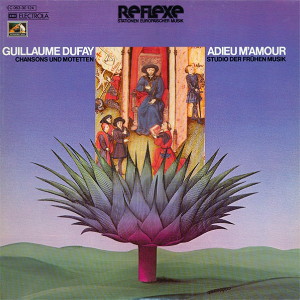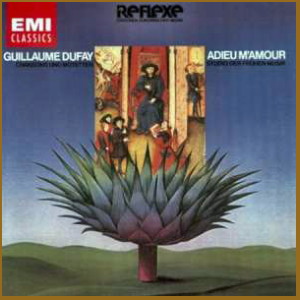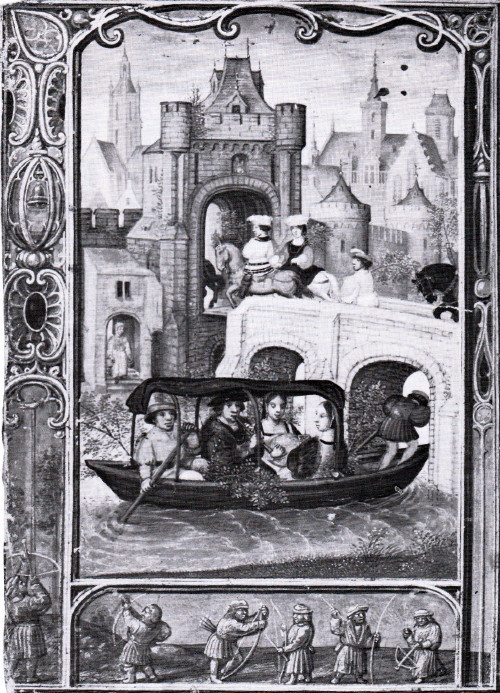 |
1 LP -
1C 063-30 124 - (p) 1974
|

|
| 1 CD - 8
26493 2 - (c) 2000 |
 |
1 CD -
CDM 7 63426 2 - (c) 1990
|
|
| GUILLAUME
DUFAY (1400-1474) - Adieu m'amour
(Chansons und Motetten) |
|
|
|
|
|
| - Bon jour, bon
moys, bo·e sepmayne |
3' 00" |
|
| - Helas mon
dueil, a ce cop sui ie mort |
2' 58" |
|
| - Pour l'amour
de ma doulce amye |
3' 36" |
|
| - Ce moys de may |
2' 15" |
|
| - Se la face ay
pale |
3' 21" |
|
| - J'atendray |
1' 48" |
|
| - Craindre vous
vueil |
4' 34" |
|
| - Ce jour de
l'an |
1' 42" |
|
| - Adieu m'amour |
5' 58" |
|
|
|
|
| - Vergene belle |
3' 43" |
|
| - Quel fronte
signorile in paradiso |
2' 44" |
|
| - Mirandas parti
haec urbs florentina puellas |
3' 33" |
|
| - Magnanimae |
3' 56" |
|
| - O gemma, lux
et speculum |
3' 05" |
|
| - Christe,
redemptor omnium |
4' 27" |
|
|
|
|
STUDIO DER FRÜHEN
MUSIK / Thomas Binkley, Leitung
|
|
| -
Thomas Binkley, Laute, Citol,
Duoçaine, Flöte, Gittern |
|
| -
Sterling Jones, Rebec, Fidel,
Citol, Douçaine, Regal |
|
| -
Andrea von Ramm, Gesang, Harfe,
Organetto |
|
| unter
Mitwirkung von |
|
| -
David Kehoe, Gesang |
|
|
|
|
|
Luogo
e data di registrazione |
|
Bürgerbräu.
München (Germania) - 1-3 maggio
1973
Munstermuseum, Basel (Svizzera) -
17 giugno 1974
|
|
|
Registrazione: live /
studio |
|
studio |
|
|
Producer / Engineer |
|
Gerd
Berg / Johann-Nikolaus Matthes
|
|
|
Prima Edizione LP |
|
EMI
Electrola "Reflexe" - 1C 063-30
124 - (1 lp) - durata 52' 09" -
(p) 1974 - Analogico |
|
|
Prima Edizione CD |
|
EMI
"Classics" - CDM 7 63426 2 - (1
cd) - durata 52' 11" - (c) 1990 -
ADD |
|
|
Edizione CD |
|
EMI
"Classics" - 8 26493 2 - (1 cd) -
durata 52' 09" - (c) 2000 - ADD |
|
|
Note |
|
- |
|
|
|
|
|
 Guillaume
Dufay (1400-1474) -
Chansons und Motets Guillaume
Dufay (1400-1474) -
Chansons und Motets
No other priest ever
wrote so many love songs as
did Guillaume Dufay. Who was
he? Why does he capture our
attention?
There are a few creative
artists in the course of the
last several centuries, who
seem to have a special
significance. Everyone has
heard of Dante, not everyone
has heard of Sacchetti. The
reason is not simply that
Dante is a better poet, it is
that he became the symbol of a
period in literary history,
the one whose works are
considered the main event of
the period.
Such an artist is Dufay, whose
name is far better known than
his works. Dufay is the
composer we are led to
associate with the Burgundian
court in the 15th century, a
lavish court with a glamorous
history, a court often held to
play the central cultural role
in the period (c.f. Huizinga,
Waning of the Middle Ages),
a court with which more than
ten composers were intimely
associated, including some
very well known, such as
Binchois, Hayne and Busnois.
Dufay was born in France about
the year 1400, and by the time
he was 20 he was in Italy,
writing music for the
Malatestas. Three pieces for
this family are dated 1420,
1423 and 1426. 1427 he was in
Bologna, and in that city the
following year he was ordained
a priest. He then spent some
years as a singer in the Papal
choir in Rome. 1437 he worked
in Ferrara, and the next year
he went to work at the court
of Savoy. In
his will Dufay mentions that
he spent some seven years in
their service that would be
from 1438-1445. That makes him
about 45 years old. The
following year a document
naming him as a canon at St.
Wandru in Mons
gives him for the first time
the title of Burgundian
chapelmaster, clearly an
honorary title for thus far in
his career he has been busy
elsewhere. From 1451 on he
lived in Cambrai and travelled
a great deal. He died then
1474, leaving behind over 200
compositions in the sacred and
secular spheres. We see that
the Burgundian court plays
very ittle role in his
biography.
We see also that our
song-writing priest was
clearly a composer by
profession, becoming a priest
much as some composers today
acquire academic status - only
as a matter of elegibility. As
a composer he had such force
as to become for music what
Jan van Eyck, his
contemporary, became for
painting. There was no
collected work" edition of
his music during his lifetime,
as both Machaut
and Wolkenstein before him had
seen realized. However, his
name is omnipresent in the
manuscript sources of the 15th
century, both in the central
Burgundian chansons and the
peripheral sources from Italy,
Austria and Germany, etc..
It is
this presence in such an
unusual number of sources from
all over Europe, a presence
thouroughly warranted by his
reputation, that made him the
symbol of 15th century music
for us. And it is only human
that we wish to associate this
composer
whose works were in the 15th
century most widely
disseminated, primarily with
the large and most influencial
and secular court of Burgundy,
even if there is very little
connection at all.
As we are dealing with a
selection from a large
repertory we cannot present a
statistical representation of
Dufays over five-score
secular songs and many other
compositions. We decided to
limit our selection to pieces
designed for small ensemble,
pieces generally of a solistic
character, pieces which
reflect some specific artistic
attitude, pieces which
themselves occupy some
specific historical pitch.
No other chanson of Dufay is
represented in as many
sources, the runner-up is Se
la face ay pale, also a
very famous piece represented
in nine sources. This last is
a ballade équivoque,
in which the last syllable of
each line is the same, but has
each time a different meaning.
Dufay himself based a mass on
this chanson. This is not the
place for a detailed
discussion of the works,
although a word about the
forms may aid the listener in
grasping certain important
aspects of the music. The
motets, for example,
frequently employ this
structure:
- introduction (vocal) lst
section (with instrumental
isorhythmic tenor)
- 2nd
section (new pitches, same
rhythm)
- 3rd section (the isorhythmic
tenor is in smaller
note-values, quickening the
tempo by one third)
The motets, of course,
following the 13th-14th
century tradition always have
two texts going on at once,
and the melodic character of
the vocal lines is not
song-like, but composed of
rhythmic cells which together
present a sound-picture which
is difficult to grasp. This is
music which progresses and
moves forward, and does not
look back. Not so with the
chansons. Here the structural
principle is reiteration.
Three structures account for
most of the chansons: (letters
mean musical sections, capital
letters mean that section is
sung with the very same text)
- Virelai (the fewest): A bb a
A
- Ballade: a a b (with envoy
in final stroph)
- Rondeau (the most): A B a A
a b A B
The envoy at the close
of a ballade is simply a
repeat of the last few musical
phrases with new text. The
idea is to bring the work to a
definite close, similar to the
conclusion of the rondeau
or virelai. The virelai
accomplishes this by repeating
the first line of text and
music, the rondeau the
first two lines of text and
music.
Within these fixed structures
is a world of detail, of
balances, of intriguing
relationships, as disguised as
the tiny birds in bushes of a
Flemish landscape. The texts
are not to be taken too
seriously; they are seldom of
the literary quality we expect
from Machaut,
the trouveres or the
troubadours. The musical
architecture has largely
replaced the literary element
here, so we must focus on
musical detail.
Thomas
Binkley
The
instruments employed are the
instruments of the period:
- Rebec: Eugen
Springer, Frankfurt
- Rebec:
Fabrizio
Reginato, Fonte Alto (Tv)
Italy
- Vielle: Fabrizio
Reginato, Fonte Alto
(Tv) Italy
- Vielle:
Fabrizio
Reginato, Fonte
Alto (Tv) Italy
-
Luter: maker
unknown
-
Luter: Fabrizio Reginato, Fonte Alto (Tv) Italy
-
Harp: Franz
Novy, Vienna
-
Gittern: Fabrizio Reginato, Fonte Alto (Tv) Italy
-
Psaltery:
maker unknown
-
Douçaine: Günter
Körber,
Berlin
-
Flute
(Recorder):
von Huene,
Boston, USA
-
Regal: Mads
Kjersgaard, Upsala,
Sweden
-
Organetto:
Ahrend &
Brunzema, Loga
bei Leer,
Germany
Tambourin:
A.T.
Camposarcone,
London
|
|
|
EMI Electrola
"Reflexe"
|
|
|
|

